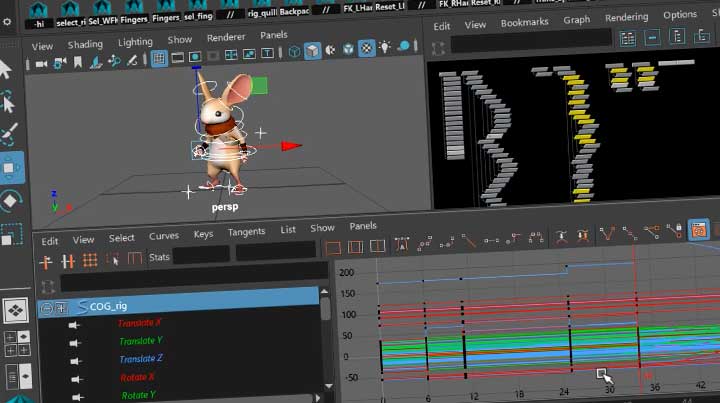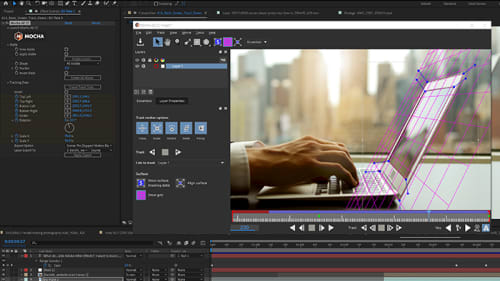Cover image via
Well, here we have a simple and straightforward tutorial made by flomotion, to track the movement in a shot using Mocha in After Effects by leveraging tracking data to substitute a talent’s head. As you can easily imagine, we start inside After Effects, and all we need is two clips: the background-clip, where we intend to place our face,. Mocha Pro 2020 is here! Mocha is the world’s most recognized and powerful planar tracking and clean up tool for VFX and post-production. In fact, Mocha Pro features GPU-accelerated tracking and object removal, advanced masking with edge-snapping, stabilization, lens calibration, 3D camera solver, stereo 360/VR support, and more. New in Mocha 2020. The Mocha tracker is an award-winning planar tracking software that comes bundled with After Effects. MochaImport+ helps you to get the most out of it - whether you use the Mocha Plugin that’s bundled with Ae, or any other full or plugin version of Mocha. Which version of After Effects are you using? If it's AE 16.0 (CC 2019) then the Mocha plug-in has been rebuilt, and no longer includes an option to export tracking data. All you have to do is close Mocha and your tracking data is saved in the plug-in. It's significantly more powerful, and easier to use, than previous versions of Mocha AE. Mocha AE is the planar tracking and masking plug-in bundled with Adobe After Effects.Get started with this quick tutorial. Mocha AE is now found under the Animation Menu (Track in Boris FX Mocha) or under the Effects menu (Boris FXMocha AE).

There’s more than one way to pull off motion tracking in After Effects. Here’s a few of them!
After Effects is a fantastic tool for VFX work. This is especially true for motion tracking. However, the tracker you use to motion track your footage might not be the best choice depending on your specific clip. Let’s take a look at six different ways to execute motion tracking in After Effects and discuss when certain tracking features should and shouldn’t be used.
1. One Point Track
When to Use It: Very quick 2D tracking situations centered around a single point with no warping.
The single-point tracker built into After Effects has long been a go-to tool for motion artists, but you need to be careful with single-point tracks because footage doesn’t normally shake in 2D space only. After Effects uses contrast to find track points, so you’ll need to make sure you set your tracker on a well-defined point. If you’re in a rush, one-point tracking will work, but for most professional circumstances, you’ll want to at least use two-point tracking.
In this tutorial from Live Tech Australia, we take a look at how to use the single-point tracker in After Effects.
2. Two Point Track
When to Use It: On footage with mild to moderate levels of camera shake.
Two-point tracking is fantastic for simple camera movements, as long as there are a few contrasted elements for the tracker to track. Two-point tracking is notably superior to single-point tracking because it can track rotation and scale, not just position.
This video from Robert’s Productions shows us how to use two-point tracking to add text to a scene.
3. Corner Pin Track
Mocha For After Effects Download
When to Use It: Basic screen replacement.
If you do a lot of commercial or sci-fi work, then you probably do a lot of screen replacements. In order to help make screen replacements easier, After Effects has a built-in corner pin tracker that is designed to work with any four point surface. While it’s designed to work with screens, it can also work with picture frames, signs, and simple surfaces. In this video tutorial from LinkTCOne, we take a look at how to use the corner pin tracker to replace a picture frame in After Effects.
Mocha Tracking In After Effects
4. 3D Camera Tracking

When to Use It: Matte painting, set extensions, and compositing.
One of the most powerful features to hit After Effects in recent years is the 3D camera-tracking tool. The tool essentially automatically creates dozens of track points in your footage and allows you to select which ones to use after the computer processes the footage. This is your best tracking option directly in After Effects. However, the 3D camera tracker can take quite a while if you have a long clip.
This tutorial from thevfxbro shows us how to use the 3D camera tracker to ‘composite’ a Christmas tree into a shot.
5. Planar Tracking Using Mocha
When to Use It: Advanced tracking on flat surfaces.
If you have a very difficult-to-track flat surface, then the planar tracking feature in mocha Pro is the way to go. Unlike After Effects, mocha Pro will use predictive tracking to track the position of an object even if a portion of the tracked object is offscreen. Tracking data can then be exported from mocha into After Effects.

This quick video tutorial from short-form video shows us how to planar track in mocha.
6. Spline Tracking
When to Use It: Complex camera tracking jobs.

If you’ve exhausted all of the other options on this list, or simply want the most accurate track possible, then spline tracking in mocha Pro is the way to go. Spline tracking can track any type of shape because you custom create the tracking plane. Essentially, you trace around the object you want to track and mocha will try its best to keep track of the object. Data can then be exported to After Effects.
This tutorial from mocha planar tracking & vfx tools shows us how to use spline trackers to do beauty retouching in After Effects.
Have any other tips for motion tracking in After Effects? Share them in the comments below!
Think the After Effects face tracker is amazing? This mocha Pro tutorial explains why it may not be the best option for tracking.
Mocha Pro is by far a better tracker than After Effects due to its expanded functionality and spline-based track system. That’s not to say that the built-in tracking features in After Effects aren’t useful. They are, but only up to a point. If you’re working on a high-end film or commercial job, you definitely want to refine your tracks using mocha Pro as After Effects can leave some less-than-impressive results.
In this video tutorial created by Imagineer Systems (the people that make mocha Pro), we take a look at the impressive ways in which mocha Pro can track faces. All of that tracking data can then be applied to your footage in After Effects for color grading and compositing. The tutorial covers:
- Using splines in mocha Pro
- Exporting tracking data from mocha Pro
- Importing tracking data into After Effects
- Planar tracking
The thing that makes this technique so much better is the fact that it uses a planar tracker rather than a pixel based tracker. The mocha Pro tracker can also deal with points that go on and off of the screen, so your track points should be obscured if a portion of your subject leaves the frame.
This video was first shared by Imagineer Systems on their Vimeo page. Thanks for sharing guys!
Like any other technique in After Effects,good tracking takes time to learn. If you stick with it, you’ll be able to easily work in After Effects and mocha Pro seamlessly.
Want to learn more about tracking in After Effects? Check out a few of the following links:
Have any other tips for motion tracking in mocha Pro or After Effects? Share in the comments below.
Sign In
Register
- Access to orders in your account history
- Ability to add projects to a Favorites list
- Fast checkout with saved credit cards
- Personalized order invoices
Create Account
